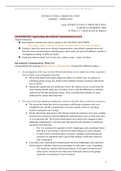Samenvatting
Summary IBCOM YEAR I - Intercultural Communication (CM1010)
- Instelling
- Erasmus Universiteit Rotterdam (EUR)
Summary of all the compulsory literature of the course Intercultural Communication (CM1010) of the International Bachelor of Communication and Media. Includes chapters 1, 2, 4, 6, 7, 8 of Piller's book 'Intercultural Communication: a critical introduction and all the articles from the authors: Esse...
[Meer zien]




